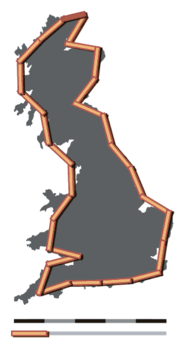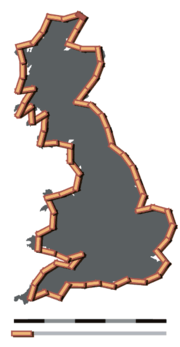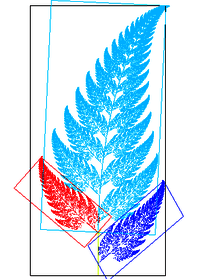Coastline paradox


The coastline paradox is the counterintuitive observation that the coastline of a landmass does not have a well-defined length. This results from the fractal-like properties of coastlines. The first recorded observation of this phenomenon was by Lewis Fry Richardson[1] and it was expanded by Benoit Mandelbrot.[2]
More concretely, the length of the coastline depends on the method used to measure it. Since a landmass has features at all scales, from hundreds of kilometers in size to tiny fractions of a millimeter and below, there is no obvious size of the smallest feature that should be measured around, and hence no single well-defined perimeter to the landmass. Various approximations exist when specific assumptions are made about minimum feature size.
Mathematical aspects
The basic concept of length originates from Euclidean distance. In the familiar Euclidean geometry, a straight line represents the shortest distance between two points; this line has only one length. The geodesic length on the surface of a sphere, called the great circle length, is measured along the surface curve which exists in the plane containing both end points of the path and the center of the sphere. The length of basic curves is more complicated but can also be calculated. Measuring with rulers, one can approximate the length of a curve by adding the sum of the straight lines which connect the points:

Using a few straight lines to approximate the length of a curve will produce a low estimate. Using shorter and shorter lines will produce sums that approach the curve's true length. A precise value for this length can be established using calculus, a branch of mathematics which enables calculation of infinitely small distances. The following animation illustrates how a smooth curve can be meaningfully assigned a precise length:

However, not all curves can be measured in this way. A fractal is by definition a curve whose complexity changes with measurement scale. Whereas approximations of a smooth curve get closer and closer to a single value as measurement precision increases, the measured value of fractals may change wildly.





The length of a "true fractal" always diverges to infinity, as if one were to measure a coastline with infinite, or near-infinite resolution, the length of the infinitely smaller bends of the coastline would add up to infinity.[3] However, this figure relies on the assumption that space can be subdivided indefinitely. The truth value of this assumption—which underlies Euclidean geometry and serves as a useful model in everyday measurement—is a matter of philosophical speculation, and may or may not reflect the changing realities of 'space' and 'distance' on the atomic level (approximately the scale of a nanometer). The Planck length, many orders of magnitude smaller than an atom, is proposed as the smallest measurable unit possible in the universe.
Coastlines differ from mathematical fractals because they are formed by numerous small events, which create patterns only statistically.[4]
Practical
In reality, permanent features of the coastline of order of size 1 cm or less do not exist, because of erosion and other action of the sea. In most places the minimum size is much larger than this. Thus the concept of an infinite fractal is not applicable to the coastline.
For practical considerations, an appropriate choice of minimum feature size is on the order of the units being used to measure. If a coastline is measured in kilometers, then small variations much smaller than one kilometer are easily ignored. To measure the coastline in centimeters, tiny variations the size of centimeters must be considered. However, at scales on the order of centimeters various arbitrary and non-fractal assumptions must be made, such as where an estuary joins the sea, or where in a broad tidal flat the coastline measurements ought to be taken. Using different measurement methodologies for different units also destroys the usual certainty that units can be converted by a simple multiplication.
Extreme cases of the coastline paradox include the fjord-heavy coastlines of Norway, Chile and the Pacific Northwest of North America. From the southern tip of Vancouver Island northwards to the southern tip of the Alaska Panhandle, the convolutions of the coastline of the Canadian province of British Columbia make it over 10% of the entire Canadian coastline (including the maze of islands of the Arctic archipelago)—25,725 km (15,985 mi) out of 243,042 km (151,019 mi) over a linear distance of only 965 km (600 mi).[5]
See also
- Coastline problem
- Fractal dimension
- Gabriel's Horn, a geometric figure with infinite surface area but finite volume
- How Long Is the Coast of Britain? Statistical Self-Similarity and Fractional Dimension
- Paradox of the heap
- Zeno's paradoxes
- Alaska boundary dispute Alaskan and Canadian claims to the Alaskan Panhandle differed greatly, based on competing interpretations of the ambiguous phrase setting the border at "a line parallel to the windings of the coast", applied to the fjord-dense region.
Notes and references
- ↑ Weisstein, Eric W. "Coastline Paradox". MathWorld.
- ↑ Mandelbrot, Benoit (1983). The Fractal Geometry of Nature. W.H. Freeman and Co. 25–33. ISBN 978-0-7167-1186-5.
- ↑ Post & Eisen, p. 550.
- ↑ Heinz-Otto Peitgen, Hartmut Jürgens, Dietmar Saupe, Chaos and Fractals: New Frontiers of Science; Spring, 2004; p. 424.
- ↑ Sebert, L.M., and M. R. Munro. 1972. Dimensions and Areas of Maps of the National Topographic System of Canada. Technical Report 72-1. Ottawa: Department of Energy, Mines and Resources, Surveys and Mapping Branch.
Bibliography
- Post, David G., and Michael Eisen. "How Long is the Coastline of Law? Thoughts on the Fractal Nature of Legal Systems". Journal of Legal Studies XXIX(1), January 2000.
External links
- "Coastlines" at Fractal Geometry (ed. Michael Frame, Benoit Mandelbrot, and Nial Neger; maintained for Math 190a at Yale University)
- The Atlas of Canada – Coastline and Shoreline
- NOAA GeoZone Blog on Digital Coast
